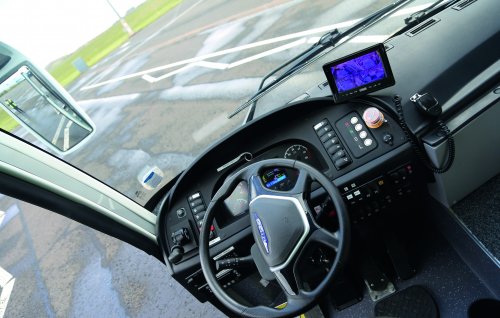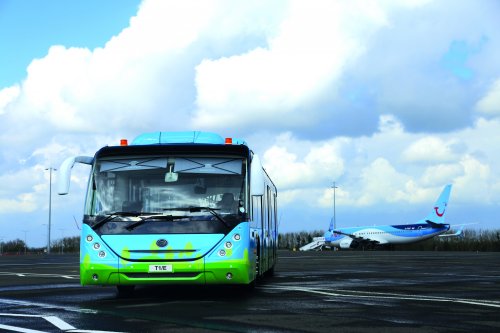
Newcastle International Airport has introduced the first Yutong electric airside bus as part of its net zero plans, reports Jonathan Welch
When we want to stick something, we turn to Sellotape. When it comes to cleaning, who hasn’t done some hoovering? And when we get to the airport, we board a ‘Cobus’ to take us to the plane. The Cobus brand has become synonymous with airside passenger transport in recent years, and indeed decades, as airports around the world have moved away from adapted off-the-shelf buses and adopted the now-standard format of a three metre wide, front engined, front wheel drive people mover to transfer large numbers of passengers quickly and efficiently between remote stands and the terminal building. But whilst the Cobus brand is probably the most well-known and widely used in Europe, it isn’t the only one in town.
On a slightly blustery Wednesday in late April, Yutong UK importer Pelican Bus & Coach invited members of the trade press to look at Yutong’s offering in the segment, seen now for the first time in the UK as this first example was delivered to Newcastle airport earlier in the year. Not only does this represent the first Yutong ABe13 in the UK, but as might be expected from a marque which is making waves in the electric bus market, this example is also fully electric, with 281kWh of batteries providing quiet, clean and green transport to help Newcastle International Airport achieve its climate goals.
Newcastle Airport
Newcastle International Airport currently has a fleet which includes five Cobus and two Neoplan diesel-powered airside buses. The increasing awareness of the emissions from air travel has led airports to look closely at what they can do to reduce their own greenhouse gas emissions and improve their environmental footprint. Like many large bus operators, who have undertaken to introduce zero-emission fleets, Newcastle Airport has set itself a target of becoming a ‘net zero’ airport by 2035, a year in which it will celebrate its centenary, and in line with many other airports across Europe.
[wlm_nonmember][…]By subscribing you will benefit from:
- Operator & Supplier Profiles
- Face-to-Face Interviews
- Lastest News
- Test Drives and Reviews
- Legal Updates
- Route Focus
- Industry Insider Opinions
- Passenger Perspective
- Vehicle Launches
- and much more!
As part of this plan, the airport will take steps to procure and generate renewable energy as well as shifting to new technologies. Over the next 15 years, it will introduce a fleet of electric vehicles including airside and car park buses, together with improved facilities for customers with electric vehicles. The airport also aims to install solar panels to supply its own green electricity to power its electric vehicles.
Speaking about the plan, Nick Jones, the airports Chief Executive, explained: “Decarbonising the airport before 2035 will be a challenge, but this is something that we feel strongly about. Newcastle International Airport is an extremely important asset to the region and we pride ourselves on being a good neighbour. The people of the North East are at the heart of everything we do, so it is vital that we make the changes needed to be able to grow the airport in a sustainable manner that protects the environment we all live and work in.”
The move was also welcomed by local Councillor Iain Malcolm, Leader of South Tyneside Council, who said: “It is fantastic that Newcastle International Airport is leading the way for aviation and contributing to the well-being of the planet with its Net Zero 2035 strategy. The airport’s Net Zero strategy aligns closely with the ambitions of the North East to be a low carbon region. Councils and combined authorities across the region have declared climate emergencies. Collectively, we can work to bring about positive change.”
Net Zero carbon emissions are defined as when CO₂ emissions generated by human activity are balanced globally by CO₂ removals over a specific period, and is not the same as carbon neutrality. The concept does not allow for offsetting.
First electric bus
Speaking about the delivery of its first ABe13, Richard Crump, Managing Director of Pelican Bus & Coach said: “Both Pelican and Yutong are delighted to have been able to work with the team at Newcastle International Airport to bring into service the first electric zero emission airside bus in the UK. This bus will contribute to reducing both the airport’s carbon footprint and vehicle operating costs as well as offering passengers an enhanced experience on their journey to and from their aircraft.”
So how does the new bus stack up?

Saloon
Thanks to the almost universal airport standard format, the 110-passenger capacity bus feels very familiar, despite the electric driveline and a different name on the badge. The ABe13’s 3-metre width serves to somewhat disguise its 13.8m length, and an external height of 3.25m gives an internal height of 2.45m.
With three wide outward-swinging double-doors either side, the bus has a large open saloon with just eight seats around the rear wheel arches, four facing forwards, four facing rearwards, which are marked as priority places for those less able to stand. In between, above the wheels are two small carpet-covered luggage pens, a useful place for stowing a few smaller cases and bags during the short trip to or from the plane. For the remainder of its passengers, handrails are plentiful. Straps hang from longitudinal ceiling rails, whilst each vestibule area features two vertical stanchions. Each of these is divided into three separate handrails, providing plenty of hand space. Handrails are finished in stainless steel, making them easy to maintain and clean.
The doors are glazed from top to bottom, though this example has the lower parts of the glass covered by vinyl livery elements. A manual wheelchair ramp is fitted at both front doors, for easy operation by the driver, and straps are fitted to secure a wheelchair on both left and right hand sides of the vehicle, meaning up to two can be carried.
LED lighting, in a combination of strip and spotlight form, takes care of internal illumination, whilst the ceiling is perforated to reduced noise. Also fitted to the ceiling in the centre of the bus is a pair of flat screen monitors, one facing each way, for providing audio-visual passenger information.
Heating and cooling is seen to by independent air conditioning units mounted on the roof, with a separate unit for the large, glass-partitioned cab area, and by heaters neatly mounted around the saloon at floor height. On a sunny but blustery day on the airfield, the heating proved effective and welcome relief from the wind!
The large windows give a good view, although considering the bus’ intended environment, it is perhaps more important to note that they make the interior bright and airy. Although air-conditioning is fitted, openable side windows are also installed. The airiness is helped by the large rear window, which has another handrail along its lower edge, and the full width glass partition which divides the cab area. This sits atop a large luggage shelf, which covers the front wheels, batteries and other associated electrical equipment. On the cab side of this partition, removable panels allow easy access.
On our short journey around the airport, the ride appeared smooth, and noise levels in the saloon low.

Cab
Moving forward into the cab, most of the controls will be familiar to any bus driver, even if the layout is a little different. As with most, if not all such buses, the ABe13 is left-hand drive. In an airport setting, this hardly matters. Access for the driver and to the front ‘passenger’ seat is via pneumatic swing doors, though manual doors are an option. Cross-cab access is possible though not really intended, with relatively narrow areas for the driver and passenger seats separated by the wide, carpet-topped equipment housing – which on a diesel model would conceal the engine.
The dashboard appeared well laid-out, with main controls all in easy reach, although the nature of the airport environment prevented any kind of test drive. However, our driver for the launch event, Aaron, said that the bus compared well to the diesel Neoplan and Cobus vehicles he had driven. He praised the turning circle, which he said was better, as well as the smoothness of both acceleration and braking as a result of the electric driveline. Lest anyone be in any doubt about the make, both electrically-operated sunblinds in the cab featured a large Yutong logo, as did the rear window.
Thanks to the large 281kWh battery capacity, the bus is expected to be able to perform its airport duties for a number of days without recharging, even with heating or air-conditioning running whilst waiting for a flight to disembark. In a normal day, the bus would be expected to make around 15 trips between the terminal building and an arriving or departing plane.
At the time of CBW’s visit, the bus had been in service for a number of weeks, and only recharged twice, though this was no doubt helped by the significantly reduced volume of air traffic as a result of Covid-19. The depressing effects of the pandemic were visible around the airfield, with aircraft belonging to a number of airlines laid up, engines covered over, awaiting the return of passengers and international travel. Whilst the return to air travel might be slow, with a knock-on effect on the ability of airport operators to invest, as more and more airports look to de-carbonise their operations and improve their green credentials, buses such as this will play an ever-more vital part in their operations.



